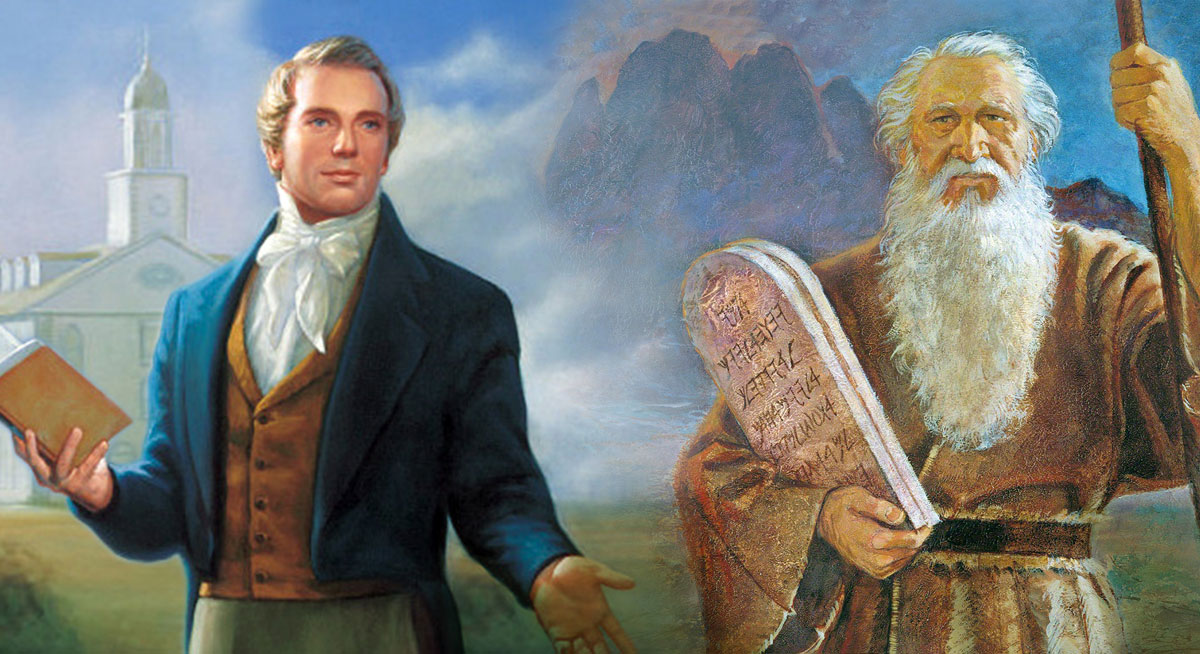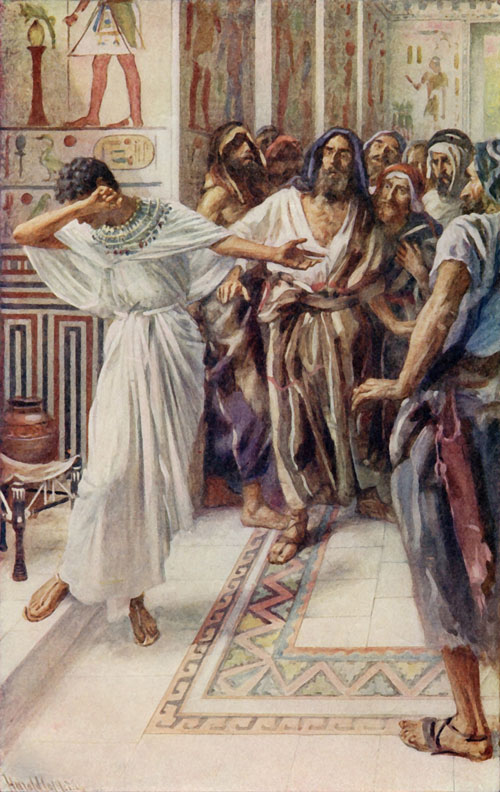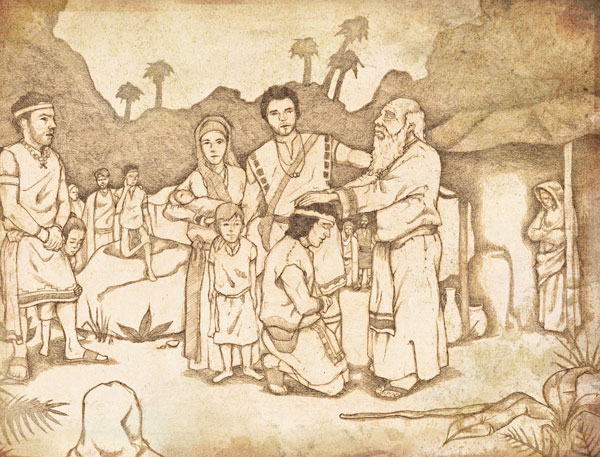You are here
How Lehi Likened the Scriptures to Himself

2 Nephi 3:18
The Know
As part of his last blessing upon his son Joseph, Lehi quoted some of the words of Joseph of Egypt (see 2 Nephi 3:6–21). Most of what Lehi quoted to his son is similar to the Joseph Smith Translation of Genesis 50:24–38.1 However, the differences between the Joseph Smith Translation and Lehi's blessing in the Book of Mormon show how Lehi specifically applied the scriptures to the lives of his descendants.
In the Joseph Smith Translation of Genesis 50, God told Joseph of Egypt, “I will raise up Moses, and a rod shall be in his hand, and he shall gather together my people, and he shall lead them as a flock, and he shall smite the waters of the Red Sea with his rod” (JST Genesis 50:34). He also said that Moses would, “have judgment, and shall write the word of the Lord. And he shall not speak many words, for I will write unto him my law by the finger of mine own hand. And I will make a spokesman for him, and his name shall be called Aaron” (v. 35). But the translation concludes simply by saying, “And it shall be done unto thee in the last days also, even as I have sworn” (v. 36).
This last statement could be interpreted in many different ways. What, exactly, would be done to the seed of Joseph of Egypt “in the last days also” as God had sworn? Lehi clarified that a modified version of God’s blessing, as recorded in the two preceding verses (JST Genesis 50:34–35), would be given to the descendants of Joseph of Egypt “in the last days also.” In 2 Nephi 3:17, Lehi said that God would, “raise up a Moses” (Joseph Smith) in the last days, just as God had raised up the original Moses in ancient times (see JST Genesis 50:34).
God also said He would “give power” to Joseph Smith “in a rod” (2 Nephi 3:17), just as God had given Moses power to deliver the Israelites out of Egypt with his rod (see JST Genesis 50:34). Because a “rod” is associated with the “word of God” in the Book of Mormon (1 Nephi 11:25), this is likely a reference to Joseph’s power to bring forth scripture such as the Book of Mormon, Pearl of Great Price, and the Doctrine and Covenants.2 This idea is supported by the next phrase: “I will give judgment unto him in writing” (2 Nephi 3:17), just as Moses would “have judgement” and “write the word of the Lord” (JST Genesis 50:35).
Finally, the Lord told Joseph He would “make for him a spokesman. And I, behold, I will give unto him that he shall write the writing of the fruit of thy loins, unto the fruit of thy loins; and the spokesman of thy loins shall declare it” (2 Nephi 3:18). Oliver Cowdery was, in some ways, Joseph’s spokesman in the same way that Aaron was a “spokesman” to Moses (see JST Genesis 50:35). Oliver physically copied down what Joseph was dictating when the Book of Mormon was being translated, so it was through him that it was “declared” to the people. However, the “spokesman” in 2 Nephi 3:18 may also be a reference to Sidney Rigdon, since Doctrine and Covenants 100:9 calls Sidney Joseph Smith’s “spokesman.”3
|
2 Nephi 3:16–18 |
JST Gen 50:34–36 |
|---|---|
|
16 I am sure of this thing, even as I am sure of the promise of Moses; for the Lord hath said unto me, I will preserve thy seed forever. 17 And the Lord hath said: I will raise up a Moses; and I will give power unto him in a rod;
and I will give judgment unto him in writing. ...
18 ... and I will make for him a spokesman. And I, behold, I will give unto him that he shall write the writing of the fruit of thy loins, unto the fruit of thy loins; and the spokesman of thy loins shall declare it. |
34 And the Lord sware unto Joseph that he would preserve his seed forever, saying, I will raise up Moses,
and a rod shall be in his hand, and he shall gather together my people, and he shall lead them as a flock, and he shall smite the waters of the Red Sea with his rod. 35 And he shall have judgment, and shall write the word of the Lord.
... I will make a spokesman for him, and his name shall be called Aaron. 36 And it shall be done unto thee in the last days also, even as I have sworn. |
The Why
In 2 Nephi 3, Lehi interpreted Genesis in a remarkably complex way. The subtle nuances that become apparent when comparing 2 Nephi and JST Genesis 50 strongly suggest that Joseph Smith did not simply modify 2 Nephi to produce the Joseph Smith Translation. It is much more likely that something very close to the Joseph Smith Translation of Genesis 50 was on the Plates of Brass, and that Lehi carefully reinterpreted this text to apply it to his own descendants.4
Yet the way Lehi phrased his comments is interesting. Even though he seemed to have been the one applying Genesis 50 to his own descendants, he still talked about these things as though they were what the Lord had said. This indicates that Lehi received revelation to know how to apply these Old Testament scriptures to his own family. These words would then have been doubly the word of the Lord. They were the word of the Lord to Joseph as found in the Plates of Brass, but the modified version would also have been the word of the Lord to Lehi as he received revelation about these verses.
Lehi likely read, prayed about, and pondered these verses, and then applied them to his own family. Although we will may never be in position to prophesy about our own posterity, we can still liken the scriptures to ourselves. As we read, pray about, and ponder the scriptures, as Lehi likely did, we can learn the lessons that God wants to teach us by applying the scriptures to our own lives.
Further Reading
Kent P. Jackson, “Inspired Additions to Genesis (JST, Genesis),” in Old Testament, Part 1: Genesis to 2 Samuel, Studies in Scripture, Volume 3, ed. Kent P. Jackson and Robert L. Millet (Salt Lake City, UT: Deseret Book, 1989), 35–46.
Catherine Thomas, “A Great Deliverance (2 Nephi 3–5),” in Book of Mormon, Part 1: 1 Nephi to Alma 29, Studies in Scripture, Volume 7, ed. Kent P. Jackson (Salt Lake City, UT: Deseret Book, 1987), 103–114.
- 1. For one example, see Joseph Fielding McConkie and Robert L. Millet, Doctrinal Commentary on the Book of Mormon, 4 vols. (Salt Lake City, UT: Bookcraft, 1987–1992), 1:210.
- 2. It is also possible that this is a reference to Oliver Cowdery’s divining rod, although the context does not necessarily support this. See Jeffrey G. Cannon, “Oliver Cowdery’s Gift,” in Revelations in Context, December 15, 2012, online at history.lds.org. For more on the rod of iron, see Matthew L. Bowen, “What Meaneth the Rod of Iron?,” Insights: A Window on the Ancient World 25, no. 2 (2005): 2–3. For more on the Book of Mormon as the rod of iron, see Matthew Bowen, “‘Nephi’s Good Inclusio,” Interpreter: A Journal of Mormon Scripture 17 (2016): 194.
- 3. See Brant A. Gardner, Second Witness: Analytical and Contextual Commentary on the Book of Mormon, 6 vols. (Salt Lake City, UT: Greg Kofford Books, 2007), 2:60. For an in-depth discussion of this idea, see Catherine Thomas, “A Great Deliverance (2 Nephi 3–5),” in Book of Mormon, Part 1: 1 Nephi to Alma 29, Studies in Scripture, Volume 7, ed. Kent P. Jackson (Salt Lake City, UT: Deseret Book, 1987), 106–107.
- 4. See Kent P. Jackson, “Inspired Additions to Genesis (JST, Genesis),” in Old Testament, Part 1: Genesis to 2 Samuel, Studies in Scripture, Volume 3, ed. Kent P. Jackson and Robert L. Millet (Salt Lake City, UT: Deseret Book, 1989), 44–45.
KnoWhy Citation
Related KnoWhys
Subscribe
Get the latest updates on Book of Mormon topics and research for free







